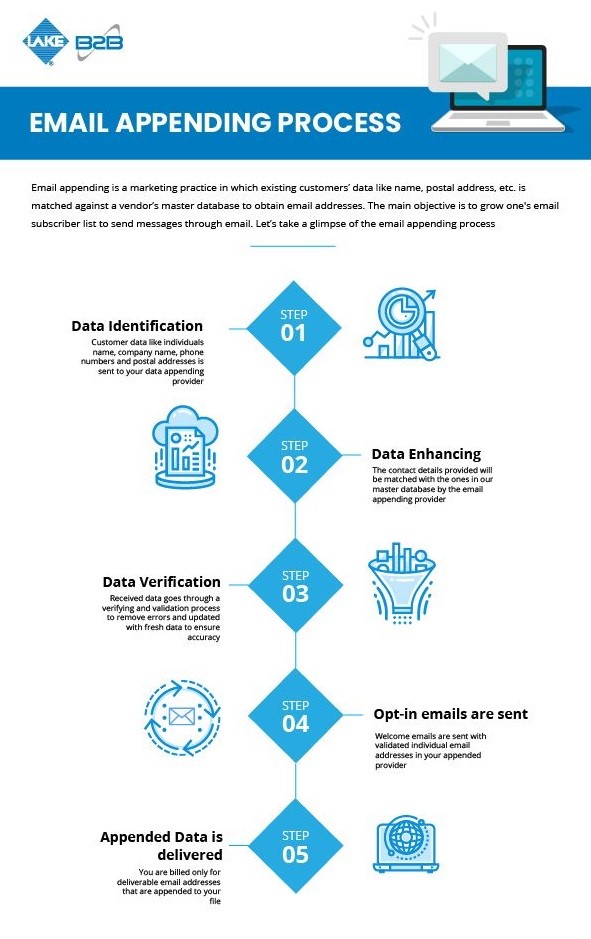
What Is Email Appending? Definition and Best Practices
What Is Email Appending?
Email appending is a practice that collects and combines data from various sources into a single file, called an append. Appends are used in marketing to gather data about email subscribers such as their names and phone numbers. This information can then be used by marketers for targeting specific audiences or for storing prospect information in a database that can be exported, imported, or otherwise accessed as needed.
Appending has been around since the early days of email marketing when it was billed as a cost-effective solution to help marketers reach their audience more effectively. Appends typically deliver results that vary depending on the quality of the data source. When the data is accurate, appending can result in highly qualified leads and even sales. When the data isn’t accurate, it can lead to a number of problems and can have a negative impact on your brand and business.
Process of Email Appending
Best Practices for Appending
The following best practices can help you effectively implement email appending without sacrificing your reputation or your business:
1. Know Your Sources:

Before collecting or using appends, make sure you know where the data is coming from. If you are using the append to collect information from your own subscribers, make sure the source of the data is reliable. If you are purchasing an append, make sure you know where it is coming from and whether or not there have been any issues with data accuracy or sources in the past.
Additional Read: How do businesses benefit from Email Appending?
2. Use Multiple Sources:
It’s best to use multiple appends so that if one particular append provider has data that is less than accurate, it will not damage your reputation or your business.
3. Double-Check Your Data:
Whatever method you use for appending, double-check all of your data before importing it into your database. Make sure the company that is providing the data has accurate information and has no issues with accuracy.
When collecting appends, ask your sources for their contact information, including phone numbers, names, and email addresses. Before uploading the collected data to your database, it’s best to call your sources to verify that they have provided you with accurate information that can be used in your business.
4. Quality Over Quantity:

It’s good practice to ask your sources for permission before collecting their information so that you can be certain they’re OK with how you will use it in your business.
5. Don’t Discard:
Once it’s in your database, keep your append data for future reference. If there are changes to your marketing strategy, you’ll be able to use the append to take advantage of those changes.
While some email appends are provided by a third party, don’t discard the data once it’s been collected and stored in your database. Instead, use append information as needed for future campaigns.
6. Use Appends selectively:
Make sure you’re not using appends that result in you wasting a significant amount of time or money – especially if those connections aren’t helping with business goals.
7. Don’t use them when you don’t need them:
If the goal of your email marketing is to maintain an existing relationship with contacts who have opted-in to your email communications, then you may not need appends. Remember that appends are best for reaching new prospects.
8. Keep Notifications Private:
If you are collecting opt-in names and email addresses from your email list, consider sharing that information with a third party for appending. This can help keep your subscriber list private, which is important for maintaining long-term, successful relationships with customers.
9. Be Transparent:
When using appends in your marketing, it’s important to be transparent with your subscribers. Let them know that you are using appends to help get the right message to the right audience.
10. Build Trust:

If you are sending out emails that include appends, remember to maintain good relationships with your contacts by providing value and building trust in each email communication you send out.
Additional Read: Importance of email appending in email marketing
11. More Money Doesn’t Mean Better Appends:
There is an old saying that “You get what you pay for.” This holds true for email appending as well. Don’t mistake a higher price tag for better data or more accurate matches between your list and append provider’s data file. The quality of the data and the accuracy of the matches are vital for your email marketing strategy.
Conclusion:
The best way to find out if email appending is right for your business is by considering the pros and cons of this marketing strategy. We’ll also provide you with a few tips on how to get started so that you can decide whether or not it will work well for your organization. Contact us today for help creating an append strategy tailored just for you! We look forward to hearing from you soon.






